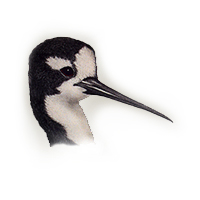|
Field
Guide IDs: BREEDING:
Marshes, wet
savannas, mud flats, shallow ponds and flooded
fields. 1? brood. DISPLAYS:
Courtship: male
alternately pecks ground/water and preens breast,
female elongates, male circles female flicking
water with bill. See: Shorebird
Communication. NEST:
Variable, may be
open or partly concealed; on dry, water-bounded
mound above tide line, on flooded flats with
360o view. Eggs often wet. Occ of mud,
sticks, shells, and debris, lined with pebbles,
shell bits, sticks. EGGS:
Buff, marked with
dark brown, black. Often nest-stained. 1.7" (44
mm). DIET:
Esp brine flies,
crayfish, brine shrimp, snails, few fish, tadpoles;
some seeds. CONSERVATION:
Winters s to s
S.A. NOTES:
Loosely colonial.
In hot environments, "belly-soaking" (transport of
water in the ventral feathers) by incubating adults
cools the incubating bird, the eggs or chicks, and
increases nest humidity; in a single day, >100
trips for water can occur. Adults distract
predators using aerial, mock incubation, and
feigned injury displays. Young hide when
threatened; swim using wings. ESSAYS: Shorebird
Feeding;
Temperature
Regulation;
Distraction
Displays;
Spacing
of Wintering Shorebirds;
Shorebird
Migration and Conservation. REFERENCES:
Grant, 1982;
Hamilton, 1975. |
